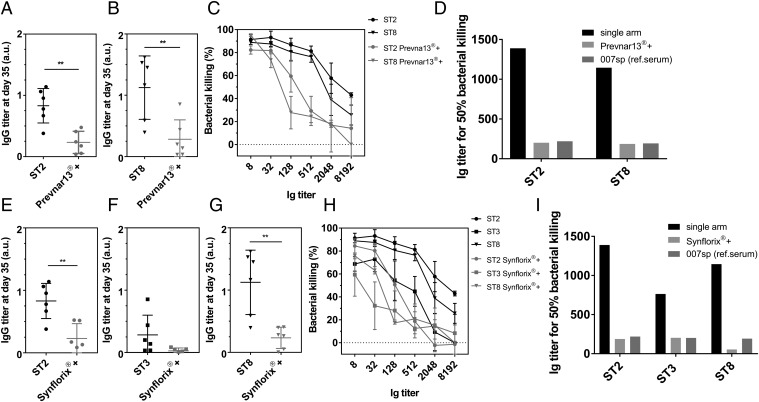Fig. 2.
Coformulation of synthetic glycoconjugates of nonvaccine serotypes with licensed polysaccharide-based conjugate vaccines. NZW rabbits (n = 4–6) were vaccinated s.c. with synthetic glycoconjugates ST2, ST3, or ST8 individually or in combination with licensed vaccines (Prevnar13+ST2+ST8 and Synflorix+ST2+ST3+ST8). (A and B) ELISA analysis of ST2 (A) and ST8 (B) polysaccharide-specific antibodies in rabbit sera at the endpoint titer dilution (1:1,000) from animals immunized with ST2 or ST8 individually or in coformulation with Prevnar13. Each dot represents the individual animal response and data were analyzed by an unpaired t test. (C) In vitro OPKA of pooled sera raised against synthetic glycoconjugate ST2 or ST8 individually or in coformulation with Prevnar13. Data presented as mean ± SD of three independent experiments. (E–G) ELISA analysis of ST2 (E), ST3 (F), and ST8 (G) polysaccharide-specific antibodies in rabbit sera at the endpoint titer dilution from animals immunized with ST2, ST3, and ST8 individually or in coformulation with Synflorix. Each dot represents the individual animal response and data were analyzed by an unpaired t test. (H) OPKA of pooled sera raised against glycoconjugates ST2, ST3 or ST8 individually or in combination with Synflorix. Data presented as mean ± SD of three independent experiments. (D and I) Comparison of antibody titers of pooled sera responsible for 50% killing of bacteria in the OPKA. IgG titers are expressed as the reciprocal serum dilution mediating 50% bacterial killing, estimated through nonlinear interpolation of the dilution-killing OPKA data. Human reference serum 007sp was used as a control. Each dot represents an individual rabbit immune response; data were analyzed by an ANOVA test, **P < 0.01.

